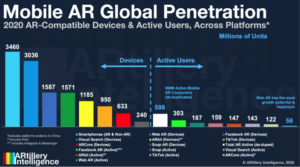By Michael Lerg
Using visualization to convey and understand the characteristics of real estate has always been a basic tenet. Throughout history, this need was adequately satisfied using two-dimensional images such as photos, renderings, and site plans. However, given the dawn of digital technologies such as Virtual Reality (VR) and Augmented Reality (AR), the game has changed. These technologies have quickly become the new benchmark for how properties are visualized, transforming the commercial real estate (CRE) market. By creating virtual access, CRE professionals are improving the way they conduct business, while often bridging the gap created by distance or time. Whether design and development, marketing and sales, or property, facility and asset management, virtual technologies are revolutionizing the way business is conducted.
As immersive technologies, both VR and AR allow the user to interact with a digital environment. While VR replaces the physical reality with a digitally created one, AR enhances the current reality. In combination, these technologies are often referred to as Mixed Reality (MR) or, more holistically, Extended Reality (XR). Together, these technologies are allowing users to better visualize properties and spaces to accelerate transactions and redefine client expectations.
Until recently, the limitations of hardware, software, and bandwidth have resulted in virtual solutions that were cost-prohibitive and cumbersome, and that often required sophisticated hardware reserved for specialized users. Today these technologies can be experienced on laptops, tablets, and smartphones at a relatively nominal cost. As 5G networks (which are up to 20 times faster than 4G), become more prevalent, these technologies are growing exponentially, providing more immersive, realistic, and effective capabilities. According to ARtillery Intelligence, there were more than 3.46 billion VR/AR-enabled mobile devices at the end of 2020, of which 598 million were actively being used. It is estimated that this number will grow to 1.73 billion by 2024. With access nearly ubiquitous and delivery facilitated by 5G networks, dominance of these virtual technologies within the CRE market is inevitable.

Applications for VR and AR are numerous. They allow users to experience the future state of a property, whether in pre-construction or pre-renovation, as well as customizing or staging a property in real-time. These virtual models also allow the immediate capture of still images without incurring the costs or delays normally associated with traditional renderings. Real Trends estimates that 90% of real estate agencies have started using VR/AR technologies to provide better services to their clients and the CRE market is quickly adopting this trend. Here are some examples of how VR and AR are transforming the CRE industry.
Applications for VR and AR
Developers
Developers are experiencing less friction and better results using VR models to pitch development projects to approval boards, investors, lenders, and prospective buyers. VR demonstrations have been proven to clarify presentations, stimulate discussion, and expedite the review and approval process.
The ability to place your audience within the virtual space, even before its construction, can reduce or eliminate the costs associated with pre-construction showrooms, physical scale models, and traditional marketing materials. Further, by accelerating the pre-sale process, these developers are able to reduce the time between construction draw-downs or investor payments, thereby increasing return on investment.
Developers are finding that AR technology is facilitating the construction process by allowing vital construction data to be overlaid on top of the user’s view of the project while under construction, creating more accurate decision-making. This enables visual surveys to provide quick, precise quality control, thus eliminating potential construction conflicts in advance.
Investment Sales and Leasing
According to Property Week, virtual tours have proven to increase the interest and resultant viewings of listings two-fold. Conversely, this technology reduces the number of wasted viewings by 40%. Prospects typically spend five to 10 times longer on websites with these virtual assets (Mass Interact). This not only improves SEO but ultimately leads to better and faster conversion rates. Furthermore, projects using VR/AR have experienced increases in pre-sales of up to 95% or more. This technology is perfect for franchisors who can recycle a virtual model over many proposed franchise sites and use it for simulation and franchisee training.
Virtual tours are readily integrated into marketing materials, both digital and traditional, by the simple use of hyperlinks. While e-marketing can easily be embedded with these links, traditional collateral simply accesses these tours by inserting QR Codes. AR technology creates 3D floorplans that appear to pop-up out of printed brochures. Once created, these virtual scenes allow for the capture of still images and videos to quickly and inexpensively refresh or target marketing. Virtual test fits are being used for real-time, iterative designs allowing the prospect to gauge suitability and accelerate decision-making.
Property, Facility, and Asset Managers
Through the use of VR and AR, property, facility, and asset managers are gaining the benefit of visualization that is leading to the proliferation of digital twin technology. A digital twin is a virtual representation that serves as the real-time digital counterpart of a physical property. These technologies are being used to reduce maintenance costs and time for repairs by quickly identifying and locating malfunctioning equipment, and even walking through the repair process. Property, facility, and asset managers are also taking advantage of these models for simulation and training exercises, as well as visualizing stacking plan data.
Another benefit derived from these virtual models is the ability to reconfigure, repurpose, or completely reimagine portfolio properties. This is particularly valuable as market factors, such as changes in consumer or worker behavior, necessitate a constant reassessment of a property’s best use. For example, the Wall Street Journal estimates that up to 25,000 stores were closed in 2020. As such, the Simon Property Group, the largest shopping mall operator in the United States, has entered into talks to convert unused shopping mall space into distribution centers for Amazon. These conversions will not happen without overcoming some challenges. In these circumstances, the ability to rapidly and iteratively experience numerous ‘what-if’ scenarios, provides the ability to explore proposed solutions that require thinking ‘outside the box’ – which is a key strength of VR/AR technologies.
Designers
Studies have shown that 75% of the population cannot effectively visualize a space three dimensionally by simply looking at two-dimensional drawings or plans. VR and AR enable the user to overcome this obstacle by placing that user directly within the space, allowing for a complete and effective evaluation. Using interactive VR tours, both the designers and their clients can virtually explore the conceptual space without the difficulties of perception often associated with conventional drawings. This immersive and interactive experience often results in improved designs, more accurate construction estimates, and the elimination of avoidable complications and costs associated with change orders. AR also provides an effective means to stage the space and evaluate its suitability.
What’s Coming Next
With the evolution of smart devices, faster bandwidth, and developing hardware and software, the capabilities and adoption of digital twin technology is growing. The symbiosis between the physical building and the digital / virtual building, is becoming more inter-related. The Building Information Model (BIM) data is being integrated with smart sensor inputs, enhanced with data analytics, AI, and machine learning. Using VR and AR, these inputs and internal systems are more easily visualized and understood. The results are leading to a reduction in energy usage and operational costs while improving the quality of life within the property.
Summary
Clearly digital technologies such as VR and AR are benefitting CRE professionals involved in development, investment sales, and leasing, property, and facility and asset management as well as design. However, return on investment for these assets is increased exponentially the earlier they are used during the lifecycle of a property. The cost to repurpose a virtual model from one stage of the lifecycle to the next is incremental, but its value during each stage is both additive and significant.

Michael Lerg
Michael Lerg is the CTO of Pix and has over 30 years of experience leading the development of Custom Visualization, Simulation, and Training applications – specializing in numerous forms of Virtual Reality and Augmented Reality. He began creating computer-based photorealistic Architectural Visualizations and Simulations in the mid-1980s, including but not limited to studies of various large corporate campus and high-rise zoning requirements, sun studies, and lines of sight from neighboring properties. His personal strengths afford him the ability to accurately and rapidly capture the needs of the client, compare and analyze available technologies, and develop the unique project specifications. The resulting documentation provides the information needed by the artists, developers, and other team members to deliver user experiences that exceed the client’s expectations while maintaining each project’s budget, timeline, and high quality of customer service.
Michael holds a B-Arch degree from California Polytechnic State University, San Luis Obispo.
You can reach him at: (281) 299-3159 or MLerg@Pix-Virtual.com.
Featured in Harrisburg Commercial Real Estate Review – Quarter 2

